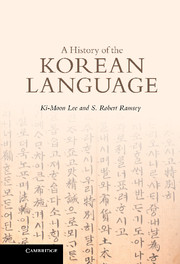Book contents
Introduction
Published online by Cambridge University Press: 05 June 2012
Summary
The story of Korean begins with the invention of the Korean alphabet. Ever since it was introduced in 1446, the Korean alphabet has been the source of precise and detailed information about the phonological and morphological structure of the language. In that year, some three years after an announcement of its creation had been made in the dynastic annals, the reigning monarch, King Sejong, promulgated a handbook introducing the new script and explaining its use, and from that point on Korean has been a language structurally accessible to future generations of linguists. Before the alphabet, there is virtually nothing in the way of quality documentation; with the alphabet, Korean structure is laid out for us to see. (The invention, how it happened, and what we know as a result, will be discussed in detail in Chapter 5.) Thus, lucid and precise written records of the Korean language go back slightly more than five and a half centuries.
That length of time may seem ancient by most standards, but it is not particularly long on the time scale of East Asian history, or even of Korean history. Chinese writing is thought to have begun around the seventeenth century BC; and it was certainly a fully developed writing system by the fourteenth century BC. That means histories were being written and literature composed almost two thousand years before the Korean alphabet was invented. That was of course in China.
- Type
- Chapter
- Information
- A History of the Korean Language , pp. 1 - 12Publisher: Cambridge University PressPrint publication year: 2011

